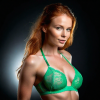Honestly, it did a long time ago for me. AI makes images look more fake than 3d renders. Yeah i know that makes no sense, but eh' what do I know. lol
Some AI stuff looks really good but yeah a lot of it looks very fake with artificially smooth, almost plasticky skin textures and maybe it's just me but a hell of a lot of the AI stuff that gets posted here looks very generic, with all the characters looking more or less the same

AI is getting really good but it's still a long way away from understanding the nuances that make women desirable. Real bodies are imperfect, and that's what makes them unique. AI tends to distill this down to an idealised formula which banishes any hint of physical individuality and results in everything looking the same

I feel most of it is because AI still involves a lot of unnecessary hassles to make a good image as exactly one intended, and that there are many more people using it as an image slot machine than a serious tool for creative expression. It can certainly lead to the feeling that they look the same due to many factors - for example, the faces generated in a single prompt will usually look very similar. Still, few care to generate each face to give it individuality. Also, AI models tend to be biased to generate idealistic females because their training sets usually contain more images of good-looking women than otherwise.
Combined with the fact that it tends to introduce anatomical deformities and other similar errors, especially if you don’t care to upscale fix them by inpainting, they give the impression of being uncanny or fake.
But I feel the other parts of what you said could be due to bias. Art is a subjective matter, of course, but if the subject is limited to (photo)realism, we can objectively compare different artistic expression methods. Contrary to what was mentioned, photorealism is one area in which AI is definitely superior to traditional methods like 3D art.
PBR, or Physically Based Rendering, is the current standard for a 3D renderer to depict materials. As the name implies, it tries to mimic how light particles interact with a surface according to its physical traits. When it became popular, it revolutionised the entire 3D field by allowing much more realistic renders previously impossible to achieve. By the way, that’s why Daz3D renders from its early days look much more cartoonish in comparison because it didn’t have a PBR workflow back then.
The problem is, however, that it’s impossible to perfectly simulate every little physical interaction between a surface like human skin and light particles that way. Even if you can render using a supercomputer, it won’t look perfectly realistic because the few - typically 3 - textures we use to depict different aspects of a physical surface are utterly insufficient to capture every little detail of it.
Of course, it is possible to achieve photorealism with 3D art, and that’s why we have all those films with perfect CGI effects. But to approach that level of realism with the PBR approach, you’ll need top-level talent in the industry as well as an enormous amount of time and effort to photo scan and/or sculpt required textures for each character you create, which is well beyond the reach of any Daz3D artist.
In comparison, AI doesn’t try to mimic physical traits. Instead, it simply predicts the most likely pixel values given a condition. So, if it was trained over photos, it would produce photographic results.
As such, it’s just a fact that AI is far better than 3D—not to mention Daz3D, which doesn't have a top-quality renderer—at producing photorealistic images. One can easily tell a Daz3D render from a photograph, but it's not always easy for an AI render.
Compare these two images: the left is a promotional image from Daz3D's website, which I'm sure was made by someone proficient at using the tool, and the right is an AI render I just made with a single prompt without any editing. Which do you think feels more "fake" with "plasticky" skin?


I think you know the answer.
P.S.: Regarding photorealism in 3D art, it's not all about materials and lighting that count. Sometimes, small details like that slightly depressed skin under the underwear on her back or those tiny body hairs on her arm that you see from the right image can give you an impression that it's a real human being.
Details like those are extremely difficult to depict with the traditional 3D modelling method and nearly impossible if you just use ready-made assets and a simplified tool, as is the case with most Daz3D creators.












